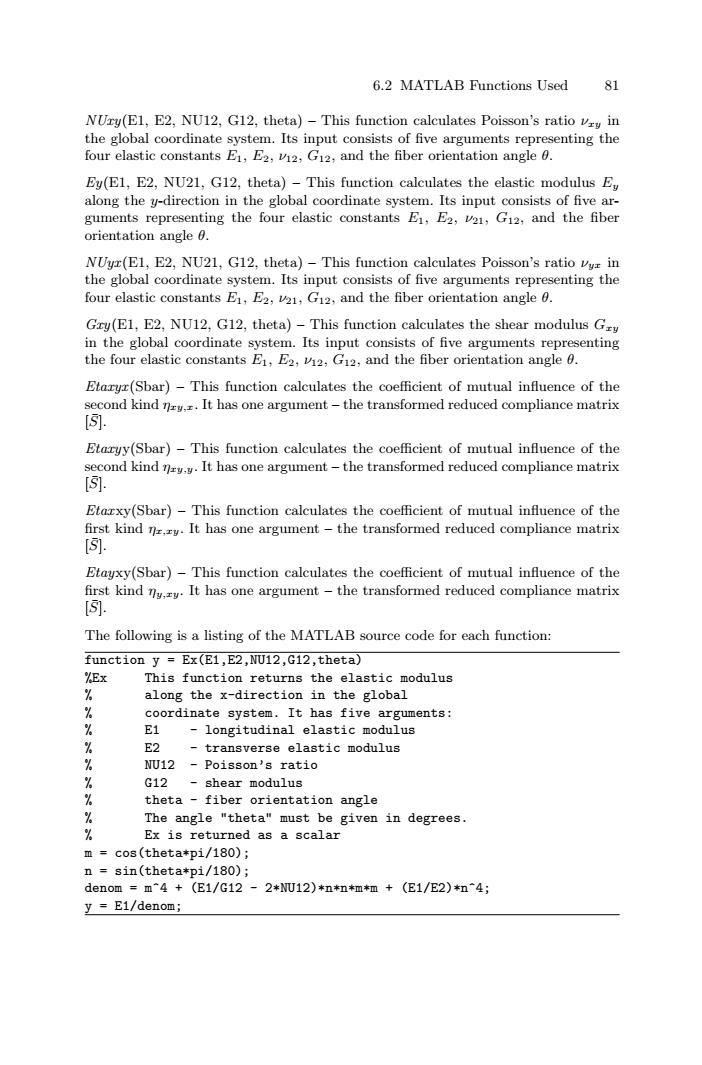正在加载图片...

6.2 MATLAB Functions Used 8 NUry(E1,E2,NU12,G12,theta)-This function calculates Poisson's ratio vry in the global coordinate system.Its input consists of five arguments representing the four elastic constants E1,E2,v12,G12,and the fiber orientation angle 0. Ey(E1,E2,NU21,G12,theta)-This function calculates the elastic modulus Ey along the y-direction in the global coordinate system.Its input consists of five ar- guments representing the four elastic constants E1,E2,v21,G12,and the fiber orientation angle 0. NUyr(El,E2,NU21,G12,theta)-This function calculates Poisson's ratio vur in the global coordinate system.Its input consists of five arguments representing the four elastic constants E,E2,v21,G12,and the fiber orientation angle 0. Gry(E1,E2,NU12,G12,theta)-This function calculates the shear modulus Gry in the global coordinate system.Its input consists of five arguments representing the four elastic constants E1,E2,v12,G12,and the fiber orientation angle 0. Etazyz(Sbar)-This function calculates the coefficient of mutual influence of the second kind ny.It has one argument-the transformed reduced compliance matrix [. Etaryy(Sbar)-This function calculates the coefficient of mutual influence of the second kind ny..It has one argument-the transformed reduced compliance matrix [. Etarxy(Sbar)-This function calculates the coefficient of mutual influence of the first kind n.y.It has one argument-the transformed reduced compliance matrix [. Etayxy(Sbar)-This function calculates the coefficient of mutual influence of the first kind ny.y.It has one argument-the transformed reduced compliance matrix [ The following is a listing of the MATLAB source code for each function: function y Ex(E1,E2,NU12,G12,theta) %Ex This function returns the elastic modulus % along the x-direction in the global 名 coordinate system.It has five arguments: E1 -longitudinal elastic modulus E2-transverse elastic modulus NU12-Poisson's ratio G12-shear modulus % theta -fiber orientation angle % The angle "theta"must be given in degrees % Ex is returned as a scalar m cos(theta*pi/180); n sin(theta*pi/180); denom=m4+(E1/G12-2*NU12)*n*n*m*m+(E1/E2)*n"4; y =E1/denom;6.2 MATLAB Functions Used 81 NUxy(E1, E2, NU12, G12, theta) – This function calculates Poisson’s ratio νxy in the global coordinate system. Its input consists of five arguments representing the four elastic constants E1, E2, ν12, G12, and the fiber orientation angle θ. Ey(E1, E2, NU21, G12, theta) – This function calculates the elastic modulus Ey along the y-direction in the global coordinate system. Its input consists of five arguments representing the four elastic constants E1, E2, ν21, G12, and the fiber orientation angle θ. NUyx (E1, E2, NU21, G12, theta) – This function calculates Poisson’s ratio νyx in the global coordinate system. Its input consists of five arguments representing the four elastic constants E1, E2, ν21, G12, and the fiber orientation angle θ. Gxy(E1, E2, NU12, G12, theta) – This function calculates the shear modulus Gxy in the global coordinate system. Its input consists of five arguments representing the four elastic constants E1, E2, ν12, G12, and the fiber orientation angle θ. Etaxyx (Sbar) – This function calculates the coefficient of mutual influence of the second kind ηxy,x. It has one argument – the transformed reduced compliance matrix [S¯]. Etaxyy(Sbar) – This function calculates the coefficient of mutual influence of the second kind ηxy,y. It has one argument – the transformed reduced compliance matrix [S¯]. Etaxxy(Sbar) – This function calculates the coefficient of mutual influence of the first kind ηx,xy. It has one argument – the transformed reduced compliance matrix [S¯]. Etayxy(Sbar) – This function calculates the coefficient of mutual influence of the first kind ηy,xy. It has one argument – the transformed reduced compliance matrix [S¯]. The following is a listing of the MATLAB source code for each function: function y = Ex(E1,E2,NU12,G12,theta) %Ex This function returns the elastic modulus % along the x-direction in the global % coordinate system. It has five arguments: % E1 - longitudinal elastic modulus % E2 - transverse elastic modulus % NU12 - Poisson’s ratio % G12 - shear modulus % theta - fiber orientation angle % The angle "theta" must be given in degrees. % Ex is returned as a scalar m = cos(theta*pi/180); n = sin(theta*pi/180); denom = m^4 + (E1/G12 - 2*NU12)*n*n*m*m + (E1/E2)*n^4; y = E1/denom;